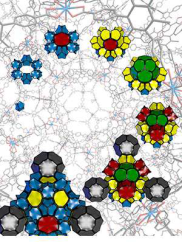博文
Science:两块基石构建出复杂的3-D材料
|||
Science:两块基石构建出复杂的3-D材料
诸平
据物理学家组织网(phys.org)2017年5月22日报道,美国西北大学化学系(Department of Chemistry, Northwestern University)、科罗拉多州矿业大学(Colorado School of Mines)、华盛顿里奇兰太平洋西北国家实验室(Pacific Northwest National Laboratory, Richland)、华盛顿大学(University of Washington)、亚利桑那州立大学(Arizona State University)以及沙特阿拉伯阿卜杜勒阿齐兹国王大学(King Abdulaziz University, Jeddah, Saudi Arabia)的研究人员合作,利用中空铀基金属-有机骨架(mesoporous uranium-based metal-organic framework,简称MOF)构成了在化学上最具挑战性的复杂的3-D材料。相关研究结果在2017年5月12日出版的《科学》(Science)杂志第356卷,6338期发表——Peng Li, Nicolaas A. Vermeulen, Christos D. Malliakas, Diego A. Gómez-Gualdrón, Ashlee J. Howarth, B. Layla Mehdi, Alice Dohnalkova, Nigel D. Browning, Michael O’Keeffe, Omar K. Farha. Bottom-up construction of a superstructure in a porous uranium-organic crystal. Science, 12 May 2017: Vol. 356, Issue 6338, pp. 624-627. DOI: 10.1126/science.aam7851.美国西北大学化学系(Department of Chemistry, Northwestern University)及沙特阿拉伯阿卜杜勒阿齐兹国王大学(King Abdulaziz University, Jeddah, Saudi Arabia)的Omar K Farha(Email: o-farha@northwestern.edu)是通讯作者。下面是美国西北大学提供的金属-有机骨架的自组装图片。更多信息请注意浏览原文和相关报道,为了便于阅读,将部分内容摘引如下,仅供参考。

Self-assembly of a metal-organic framework. Credit: Northwestern University
More information:
Two simple building blocks produce complex 3-D material
May 22, 2017 by Megan Fellman
Northwestern University scientists have built a structurally complex material from two simple building blocks that is the lowest-density metal-organic framework ever made.
Directed by design rules developed by the scientists, uranium atoms and organic linkers self-assemble into a beautiful crystal—a large, airy 3-D net of very roomy and useful pores. The pores are so roomy, in fact, that the scientists have nestled a large enzyme inside a pore—no small feat. The material can act as a protective scaffold for enzymes.
"We are building with one-atom precision," said Omar K. Farha, a research professor of chemistry in the Weinberg College of Arts and Sciences who led the research. "Our material begins at the level of individual atoms, measured by angstroms, and ends on the hundreds of microns level, where we can hold the small crystal with a tweezers and see it with the naked eye."
The study was published in the May 12 issue of the journal Science.
The material is very light, despite being made from uranium, one of the heaviest elements in the periodic table. (The scientists used uranium 238, a nonradioactive isotope.) The uranium atoms are so far away from each other in the structure that the metal-organic framework (MOF) takes the lowest density title from any of the competition.
"It is counterintuitive," said Farha, who specializes in the rational design of MOFs for catalysis, sensing and storage applications.
"This material has not been seen or predicted before. Despite its simple beginnings, our MOF's structure has an unparalleled structural complexity. And we've just scratched the surface of building sophisticated structures using simple building blocks."
The discovery unveils the potential to create general design rules for self-assembly of open, complex structures from simple building blocks while also highlighting the potential of actinides, such as uranium, in materials synthesis, Farha said.
Researchers now can apply the new set of design rules for bottom-up construction to synthesize various novel materials with pre-designed and predictable complex structures.
Metal-organic frameworks are well-ordered, lattice-like crystals. The nodes of the lattices are metals, and organic molecules connect the nodes. The new MOF, called NU-1301, is made up only of uranium oxide nodes and tricarboxylate organic linker units. This simplicity makes the MOF industrially relevant.
In addition to the structural complexity, NU-1301 has a very high surface area, pore volume and water stability and can be used to separate small organic molecules and large biological molecules, or enzymes, based on their sizes and charges.
Each unit cell—the basic unit that repeats in three dimensions to create the crystal structure—is composed of 816 uranium nodes and 816 organic linkers. One unit cell measures 173 angstroms across, and it keeps repeating itself. The unit cells assemble into pentagons and hexagons, eventually growing into a crystal that can reach a quarter of a millimeter wide.
The paper is titled "Bottom-up construction of a superstructure in a porous uranium-organic crystal."
Explore further: Modular construction—on a molecular scale
Intricacy anchored by uranium
Metal-organic frameworks generally have one level of assembly complexity: Organic linkers join inorganic nodes in a repeating lattice. Li et al. created a structure composed of cuboctahedra, assembled from uranium cations and organic linkers, that shared triangular faces to form prisms. These structures formed cages, which in turn joined to make tetrahedra that assembled with a diamond-lattice topology. This hierarchical open structure generated a huge unit cell with more than 800 nodes and linkers, containing internal cavities with diameters of 5 and 6 nm.
Science, 2017,Vol. 356, Issue 6338, pp. 624-627.
Abstract
Bottom-up construction of highly intricate structures from simple building blocks remains one of the most difficult challenges in chemistry. We report a structurally complex, mesoporous uranium-based metal-organic framework (MOF) made from simple starting components. The structure comprises 10 uranium nodes and seven tricarboxylate ligands (both crystallographically nonequivalent), resulting in a 173.3-angstrom cubic unit cell enclosing 816 uranium nodes and 816 organic linkers—the largest unit cell found to date for any nonbiological material. The cuboctahedra organize into pentagonal and hexagonal prismatic secondary structures, which then form tetrahedral and diamond quaternary topologies with unprecedented complexity. This packing results in the formation of colossal icosidodecahedral and rectified hexakaidecahedral cavities with internal diameters of 5.0 nanometers and 6.2 nanometers, respectively—ultimately giving rise to the lowest-density MOF reported to date.
https://blog.sciencenet.cn/blog-212210-1056588.html
上一篇:关注钛、钛合金的市场行情变化
下一篇:钛应用需求预测